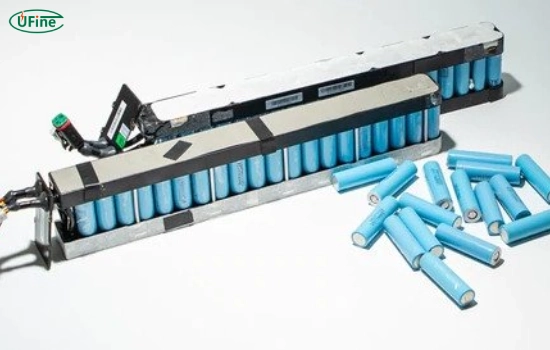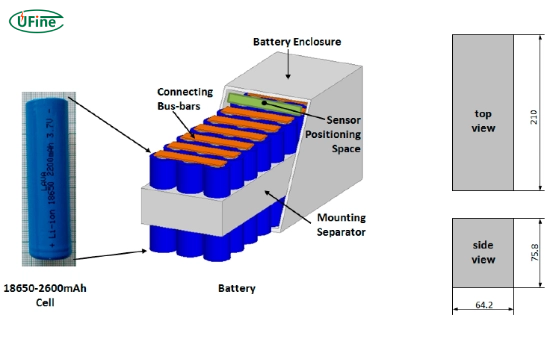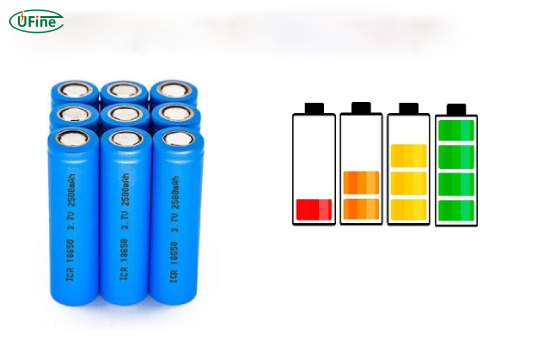In the realm of portable power solutions, the 18650 battery pack stands as a cornerstone of modern energy storage technology.
These cylindrical cells, initially designed for laptops, have evolved to power an array of devices, from flashlights to electric vehicles.
This article delves into the intricacies of the 18650 battery pack, examining its design, advantages, and optimal methods for charging.
Part 1. 18650 Battery pack
The 18650 battery pack, featuring individual cylindrical lithium-ion cells, serves as a cornerstone in modern portable power solutions. Its standardized dimensions, 18mm in diameter and 65mm in length contribute to its versatility and widespread applications across various industries.
Composition and structure
The composition of an 18650 battery pack is integral to its functionality. Comprising lithium-ion cells, each cell is constructed with a positive cathode, a negative anode, and a separator immersed in an electrolyte solution. This structure allows for the flow of lithium ions during charge and discharge cycles, facilitating the conversion of chemical energy into electrical energy and vice versa. The arrangement and quality of these components significantly influence the pack’s overall performance and longevity.
Modular configurations
Manufacturers employ various modular configurations to harness the potential of 18650 cells. Series and parallel connections are commonly used to achieve desired voltage and capacity levels. Series connections involve linking cells end-to-end to increase voltage, while parallel connections connect cells side-by-side to boost overall capacity. These configurations allow for scalability and customization, catering to the specific power needs of diverse applications, from low-power devices to high-performance systems.
Performance and energy density
The performance of 18650 battery packs is underpinned by their exceptional energy density. This high energy density enables these packs to store a substantial amount of energy relative to their size, ensuring prolonged usage and consistent power output. Their ability to maintain stable voltage throughout discharge cycles makes them ideal for applications requiring sustained and reliable power, enhancing the efficiency and effectiveness of devices.
Applications
The versatility of 18650 battery packs spans across a wide spectrum of applications. From everyday consumer electronics like laptops, tablets, and smartphones to power tools, electric bicycles, and even larger-scale applications such as electric vehicles and energy storage systems for renewable sources, these packs serve as a reliable and efficient power source. Their adaptability and high energy density make them indispensable across industries seeking portable and rechargeable power solutions.
Part 2. 18650 Battery pack design
Cell arrangement and configuration
The design of an 18650 battery pack involves meticulous cell arrangement and configuration. Manufacturers organize these cylindrical lithium-ion cells into packs using various configurations – series, parallel, or a combination of both. Series connections involve linking cells end-to-end to increase the overall voltage output, while parallel connections connect cells side-by-side to augment the total capacity. This flexibility in arrangement allows for customization based on specific power requirements of devices or systems.
Casing and enclosure
The casing and enclosure of an 18650 battery pack play a critical role in ensuring safety and protection. These packs are often housed in durable materials, such as nickel-plated steel or high-impact plastic, providing structural integrity while safeguarding the cells from external damage. Additionally, proper insulation within the casing prevents potential short circuits and ensures the efficient functioning of the pack.
18650 Battery pack BMS
Battery Management Systems are integral components of 18650 battery packs. BMS units monitor and regulate various parameters, including voltage, temperature, and charging/discharging rates, to optimize performance and ensure safety. These systems employ sophisticated algorithms to balance individual cell voltages, prevent overcharging or over-discharging, and mitigate potential risks like thermal runaway, enhancing the longevity and reliability of the pack.
Thermal regulation and ventilation
Efficient thermal regulation is essential in the design of 18650 battery packs. Thermal controls, such as heat sinks, conductive materials, and sometimes even cooling systems like fans or vents, dissipate excess heat generated during charge or discharge cycles. Proper ventilation within the pack helps maintain optimal operating temperatures, preventing overheating and preserving the cells’ integrity.
Safety features and protections
Numerous safety features are integrated into the design of 18650 battery packs to ensure user safety and pack longevity. These include built-in protection circuits that safeguard against overcharging, over-discharging, short circuits and excessive temperature fluctuations. Additionally, some packs incorporate mechanisms like pressure relief valves to mitigate internal pressure buildup, enhancing overall safety.
Sealing and waterproofing
For applications requiring resilience against environmental elements, some 18650 battery packs are designed with sealing and waterproofing measures. Sealing techniques and specialized coatings applied to the pack’s exterior protect against moisture and dust ingress, making them suitable for outdoor or rugged applications where environmental durability is crucial.
Part 3. Benefits of 18650 battery packs
Integrated management and monitoring
18650 battery packs offer integrated management and monitoring systems that surpass individual cells. These packs incorporate sophisticated Battery Management Systems (BMS) that oversee multiple cells within the pack. BMS units manage voltage, temperature, and charging/discharging rates more comprehensively, ensuring enhanced safety, efficiency, and overall performance compared to standalone cells.
Improved safety protocols
Compared to standalone 18650 cells, battery packs are equipped with heightened safety protocols. Packs integrate advanced protection circuits, temperature sensors, and built-in redundancy mechanisms. These robust safety features ensure superior protection against overcharging, over-discharging, short circuits, and other potential hazards, providing a higher level of safety in diverse applications.
Enhanced structural design
The structural design of 18650 battery packs surpasses that of individual cells. Packs are encased in sturdy materials with added insulation, offering better resistance against external damage and potential short circuits. This comprehensive design approach enhances the pack’s durability and reliability in varied environmental conditions, an advantage not present in standalone cells.
Customization and scalability
Battery packs provide unparalleled customization and scalability in contrast to individual cells. Manufacturers configure packs using series or parallel connections of multiple cells to achieve specific voltage and capacity requirements. This modularity enables tailored solutions for different applications, offering a more adaptable and versatile power solution compared to standalone cells.
Integrated thermal management
18650 battery packs incorporate advanced thermal management systems that outperform individual cells. These packs integrate superior thermal controls such as effective heat dissipation components and optimized airflow mechanisms. These systems efficiently regulate temperature, reducing the risk of overheating and ensuring optimal performance, a feature that standalone cells lack.
Streamlined integration and compatibility
Battery packs exhibit streamlined integration and heightened compatibility compared to individual cells. Their standardized design and integrated components facilitate easier installation into various devices and systems. This compatibility ensures smoother operation across a broader spectrum of applications, presenting an advantage over standalone cells in terms of seamless integration.
Part 4. How to charge the 18650 battery pack?
Charging methods
18650 battery packs require specialized charging methods that differ from individual cell charging. Charging packs often involve using dedicated smart chargers designed for multi-cell configurations. These chargers offer options for both series and parallel charging, ensuring balanced charging across all cells within the pack to maintain uniformity in voltage and capacity.
Balanced charging for packs
One key consideration is balanced charging, crucial for 18650 battery packs. This process involves ensuring that each cell within the pack is charged evenly to prevent imbalances in voltage or capacity. Dedicated smart chargers equipped with balancing functions manage each cell’s charge independently, preventing overcharging or undercharging of specific cells, which could compromise the pack’s overall performance and longevity.
Monitoring charging parameters
When charging 18650 battery packs, monitoring charging parameters is essential. Smart chargers equipped with monitoring capabilities display crucial information such as voltage, current, and temperature. This real-time data allows users to track the charging progress and detect any anomalies, ensuring safe and efficient charging without risking cell damage or pack malfunction.
Charging safety precautions
Charging 18650 battery packs requires specific safety precautions not typically needed for individual cells. Users must ensure proper ventilation during charging to dissipate heat generated during the process, preventing potential overheating. Additionally, it’s vital to charge packs on non-flammable surfaces and avoid leaving them unattended while charging to minimize any safety risks.
Avoid fast-charging practices
Unlike individual 18650 cells, fast-charging practices should be approached with caution for battery packs. While some cells might support rapid charging, it’s advisable to avoid aggressive charging rates for packs to maintain their long-term health and safety. Opting for slower, more controlled charging rates helps mitigate risks associated with excessive heat generation and potential damage to the cells within the pack.
Maintenance charging practices
Regular maintenance charging practices are essential for 18650 battery packs. Performing periodic top-up charges rather than letting the pack fully discharge helps maintain cell balance and extends the pack’s overall lifespan. Additionally, avoiding prolonged periods of storage with a fully discharged state is recommended to prevent irreversible damage to the cells.
Part 5. FAQs
-
How to charge an 18650 battery pack with BMS?
To charge an 18650 battery pack with a Battery Management System (BMS), connect the BMS to a compatible charger. The BMS regulates charging, ensuring each cell reaches a safe voltage and prevents overcharging or imbalances. -
What battery can I use instead of 18650?
Depending on the device’s requirements, alternative batteries like 21700, 20700, or other lithium-ion cells with similar voltage and dimensions might be suitable replacements for 18650 batteries. -
Are there specific safety precautions to consider when using 18650 battery packs?
Yes, several safety precautions are crucial: avoid overcharging, over-discharging, and puncturing cells, use compatible chargers, avoid mixing cells of different capacities, and handle them carefully to prevent short circuits. -
Can 18650 battery packs be mixed and matched with different capacities or brands of cells?
It’s generally not recommended to mix cells with different capacities or brands in the same battery pack. Mixing can lead to imbalances, affecting performance, capacity, and safety. -
What is the average lifespan of an 18650 battery pack, and how can its longevity be maximized?
The lifespan of an 18650 battery pack varies based on usage and care. With proper charging habits, avoiding extreme temperatures, and not over-discharging or overcharging, the average lifespan can be around 2 to 5 years or 300 to 500 charge cycles. Regular maintenance and proper use can extend its life.
Related Tags:
More Articles

LiPo Battery Discharge Rate Guide & Calculation Tips
Understand LiPo battery discharge rates, C-ratings, and how to calculate max current. Essential guide for RC, drones, and electronics users.
High‑Capacity 3S LiPo Batteries: 5000 mAh vs. 10000 mAh
Compare 3S LiPo 5000mAh vs 10000mAh batteries by weight, power, and use. Find the best fit for your drone, RC car, or boat setup.
Top 5 Applications for Small 3S LiPo Batteries
Small 3S LiPo batteries power drones, RC gear, wearables, and robotics with high energy and low weight. Making them ideal for compact electronics projects.
Building and Charging Your Own 3S LiPo Pack: A Step‑by‑Step Guide
Learn how to build, balance, and charge a 3S LiPo battery pack safely at home with this complete DIY guide for hobbyists and beginners.
How to Choose the Right LiPo Battery Plug Type?
Discover the best LiPo battery plug types, how to choose them, and expert tips for safe usage, soldering, and maintenance.






